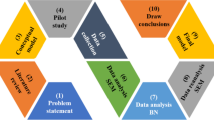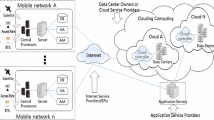Abstract
Despite its many technology maturity and significant advantages, the cloud services are still far from success in the market. In accordance with some research, security risks have been regarded as the main factors that impede activating cloud service. Accordingly, this study divides the factors of security risk into Information leakage risk, Fault recovery risk, Compliance risk, Service interruption risk and made an empirical analysis of the impact of these four factors on continuous adoption intention. The effects of security risk and adoption intention of cloud service were analyzed via the moderation effects of trust. The analytical results of China data show that bo th Information Leakage Risk and Compliance Risk have negative impact on continuous adoption intention of cloud service. Neither Fault Recovery Risk nor Service Interruption Risk is significantly related with continuous adoption intention of cloud service. The analytical results of Korea data show that Fault Recovery Risk, Compliance Risk and Service Interruption Risk significantly impact continuous adoption intention of cloud service, whereas Information Leakage Risk insignificantly impact continuous adoption intention of the cloud service.



Similar content being viewed by others
References
Cho, L.G., Park, M.C.: Technological-level evaluation using patent statistics: model and application in mobile communications. Clust. Comput. 18, 259–268 (2015)
Jarschel, M., Schlosser, D., Scheuring, S.: Gaming in the clouds: QoE and the users perspective. Math. Comput. Model. 57, 2883–2894 (2013)
Casas, P., Schatz, R.: Quality of experience in cloud services: survey and measurements. Comput. Netw. 68(1), 149–165 (2014)
Yang, K., Jia, X.: Data storage auditing service in cloud computing: challenges, methods and opportunities. World Wide Web. 15(4), 409–428 (2012)
RightScale: 2015 State of the Cloud Report: See the Latest Cloud Computing Trends. http://www.rightscale.com/lp/2015-state-of-the-cloud-report (2015). Accessed 25 August 2015
Dinh, H.T., Lee, C., Niyato, D., Wang, P.: A survey of mobile cloud computing: architecture, applications, and approaches. In: Wireless Communications and Mobile Computing. http://onlinelibrary.wiley.com/doi/10.1002/wcm.1203/full (2011). Accessed 25 August 2015
Khajeh-Hosseini, A., Sommerville, I., Bogaerts, J., Teregowda, P.: Decision support tools for cloud migration in the enterprise. In: 2011 IEEE International Conference on Cloud Computing, pp. 541–548. IEEE (2011)
Phaphoom, N., Oza, N., Wang, X., Abrahamsson. P.: Does cloud computing deliver the promised benefits for IT industry?. In: Proceedings of the WICSA/ECSA 2012 Companion Volume, pp. 45–52. ACM. http://dx.doi.org/10.1145/2361999.2362007 (2012). Accessed 25 August 2015
Armbrust, M., Fox, A., Griffith, R., Joseph, A.D., Katz, R., Konwinski, A., Lee, G., Patterson, D., Rabkin, A., Stoica, I., Zaharia, M.: A view of cloud computing. Commun. ACM. 53(4), 50–58 (2010)
Marston, S., Li, Z., Bandyopadhyay, S., Zhang, J., Ghalsasi, A.: Cloud computing—the business perspective. Decis. Support Syst. 51(1), 176–189 (2015). doi:10.1016/j.dss.2010.12.006
Rafique, K., Tareen, A.W., Saeed, M., Wu, J.Z., Qureshi, S.S.: Cloud computing economics opportunities and challenges. In: 4th IEEE International Conference on Broadband Network and Multimedia Technology. Shenzhen, 28–30, pp. 401-406 (2011) http://dx.doi.org/10.1109/ICBNMT.2011.6155965 (2011) Accessed 25 August 2015
Goodburn, M.A., Hill, S.: The cloud transforms business. Financ. Exec. 26(10), 34–39 (2010)
Harris, J., Grandgenett, N., Hofer, M.: Testing a TPACK-based technology integration assessment rubric. In: Maddux, C.D. (ed.) Research Highlights in Technology and Teacher Education 2010, pp. 323–331. Society for Information Technology & Teacher Education (SITE), Chesapeake (2010)
Jasti, H., Hanusa, B.H., Switzer, G.E., Granieri, R., Elnicki, M.: Residents’ perceptions of a night float system. BMC Med. Educ. 2009 9(52) doi:10.1186/1472-6920-9-52 (2009). Accessed 25 August (2015)
Mladenow, A., Fuchs, E., Dohmen, P., Strauss, C.: Value creation using clouds: analysis of value drivers for start-ups and small and medium sized enterprises in the textile industry. In: 26th International Conference on Advanced Information Networking and Applications Workshops 2012, pp. 1215–1220. IEEE (2012)
Marko, K.: 2014 State of Storage. http://reports.informationweek.com/abstract/24/12015/Storage-Server/Research:-2014-State-of-Storage (2014). Accessed 25 August (2015)
Kang, A.N., Barolli, L., Park, J.H., Jeong, Y.S.: A strengthening plan for enterprise information security based on cloud computing. Clust. Comput. 17, 703–710 (2014)
Mell, P., Grance, T.: The NIST Definition of Cloud Computing. US Nat’l Inst. of Science and Technology. http://csrc.nist.gov/publications/nistpubs/800-145/SP800-145.pdf (2011). Accessed 25 August 2015
Haghighat, M., Zonouz, S., Abdel-Mottaleb, M.: CloudID: trustworthy cloud-based and cross-enterprise biometric identification. Expert Syst. Appl. 42(21), 7905–7916 (2015)
Hamadaqa, M., Tahvildari, L.: Cloud computing uncovered: a research landscape. In: Ali, H., Atif, M. (eds.) Advances in Computers, vol.86, pp. 41–85 (2012)
Hussain, M., Abdulsalam, H.M.: Software quality in the clouds: a cloud-based solution. Clust. Comput. 17, 389–402 (2014)
Stamford, C.: Gartner Says Public Cloud Services Are Simultaneously Cannibalizing and Stimulating Demand for External IT Services Spending. http://www.gartner.com/newsroom/id/2220715 (2014). Accessed 25 August (2015)
Ratansingham, P., Kumer, K.: Trading partner trust in electronic commerce participation. In: Proceeding of the 22nd International Conference on Information systems, pp. 544–552 (2000)
Kim, K.K., Lee, J.W., Kim, H.S.: Impact of trust and risk on internet banking adoption. Korean Manag. Rev. 32(6), 1771–1797 (2003)
Jarvenpaa, S.L., Knoll, K., Leidner, D.E.: Is anybody out there? Antecedents of trust in global virtual teams. J. Manag. Inf. Syst. 14(4), 29–64 (1998)
Lim, N.: Consumer’s Perceived Risk: Sources versus Consequences. Electron. Commer. Res. Appl. 2(3), 216–228 (2003)
Ahn, J.H., Choi, K.C., Sung, K.M., Lee, J.H.: A study on the impact of security risk on the usage of knowledge management system: focus on parameter of trust. In: International Conference on Information systems, vol.15
Hexin, Y., Ahn, J.C.: An empirical analysis on the persistent usage of personal cloud service: a cast study of China. Proc. Korean Soc. Internet Inf. Conf. 15(2), 149–150 (2014)
Jun, C.J., Lee, J.H., Jeon, I.S.: Research about factor affecting the continuous use of cloud storage service: user factor, system factor, psychological switching cost factor. J. Soc. e-Bus. Stud. 19(1), 15–42 (2014)
Seo, K.K.: Factor analysis of the cloud service adoption intension of Korean firms: applying the TAM and VAM. J. Digit Policy Manag. 11(12), 155–160 (2013)
Park, C.S.: Study on security considerations in the cloud computing. J Korea Acad.-Ind. Co-op. Soc. 12(3), 1408–1416 (2011)
Siani, P., Azzedine, B.: Privacy, security and trust issues arising from cloud computing. In: 2nd IEEE International Conference on Cloud Computing Technology and Science, pp. 693–702 (2010)
Heiser, J., Nicolett, M.: Assessing the Security Risks of Cloud Computing. Gartner (2008)
Almond, C.: A Practical Guide to Cloud Computing Security What You Need to Know Now About Your Business and Cloud Security, pp. 6–27. Avanade Inc. (2009)
Zissis, D., Lekkas, D.: Addressing cloud computing security issues. Future Gener. Comput. Syst. 28(3), 583–592 (2012)
Foster, T., Zhao, Y., Lu, S.: Cloud computing resource management through a grid middleware: a case study with diet and eucalyptus. Cloud computing. In: IEEE International Conference, pp. 151–154 (2009). Accessed 25 August (2015)
Tarrant, D., Brody, T., Carr, L.: From the desktop to the cloud: leveraging hybrid storage architectures in your repository. In: International Conference on Open Repositories. http://eprints.soton.ac.uk/267084/1/or09.pdf (2009). Accessed 25 August (2015)
Mayer, R.C., Davis, J.H., Schoorman, F.D.: An integrative model of organizational trust. Acad. Manag. Rev. 20(3), 709–734 (1995)
Liu, C., Marchewka, J.T., Lu, J., Yu, C.S.: Beyond concern—a privacy-trust-behavioral intention model of electronic commerce. Inf. Manag. 42, 289–304 (2005)
Eastlick, M.A., Lotz, S.L., Warrington, P.: Understanding online B-to-C relationships: an integrated model of privacy concerns, trust, and commitment. J. Bus. Res. 59, 877–886 (2006)
Liao, C., Liu, C.C., Chen, K.: Examining the impact of privacy, trust and risk perceptions beyond monetary transactions: an integrated model. Electron. Commer. Res. Appl. 10, 702–715 (2011)
Rho, M.J., Kim, H.S., Chung, K.Y., Choi, I.Y.: Factors influencing the acceptance of telemedicine for diabetes management. Clust. Comput. 18, 321–331 (2015)
Ajzen, I.: The theory of planned behavior. Org. Behav. Hum. Decis. Process. 50, 179–211 (1991)
Barnes, S., Bohringer, M.: Modeling user continuance behavior in microblogging services: the case of Twitter. J. Comput. Inf. Syst. 51(4), 1–10 (2011)
Burtescu, E.: Reliability and security—convergence or divergence. Inf. Econ. 14(4), 68–77 (2010)
Weber, R.: Ontological Foundations of Information Systems. Buscombe Vicprint, Blackburn, Victoria (1997)
Rotter, J.B.: A new scale for measurement of interpersonal trust. J. Personal. 35(4), 651–665 (1967)
Wiliamson, M.: Invaders, weeds and the risk from genetically modified organisms. Experientia 49, 219–224 (1993)
Rousseau, D., Sitkin, S., Burt, R., Camerer, C.: Not so different after all: a cross-discipline view of trust. Acad. Manag. Rev. 23(3), 393–404 (1998)
Pavlou, P.A.: Consumer acceptance of electronic commerce: integrating trust and risk with the technology acceptance model. Int. J. Electron. Commer. 7(3), 101–134 (2003)
Grazioli, S., Jarvenpaa, S.: Perils of Internet fraud: an empirical investigation of deception and trust with experienced Internet consumers. IEEE Trans. Syst. Man Cybern. 30(4), 395–410 (2000)
John, W.R., James, F.R.: Cloud Computing: Implementation, Management and Security. CRC Press (2010)
Savola.: The Savola Group Annual Report 2010. http://www.savola.com/SavolaE/pdf/Savola_Annual_Report_2010_E.pdf (2010). Accessed 25 August (2015)
Davis, F.D.: Perceived Usefulness, perceived ease of use, and user acceptance of information technology. MIS Q. 13(3), 319–340 (1989)
Venkatesh, V., Davis, F.D.: A theoretical extension of the technology acceptance model: four longitudinal field studies. Manag. Sci. 45(2), 186–204 (2000)
Hansmann, K.W., Ringle, C.M.: SmartPLS Manual. http://forum.smartpls.com/viewtopic.php?f=2&t=1700 (2004). Accessed 25 August (2015)
Hulland, J.: Use of partial least squares (PLS) in strategic management research: a review of four recent studies. Strateg. Manag. J. 20(2), 195–204 (1999)
Fornell, C., Cha, J.: Partial least squares. In: Bagozzi, R.P. (ed.) Advanced Methods in Marketing Research, pp. 52–78. Blackwell, Cambridge (1994)
Fornell, C., Larcker, D.: Structural equation models with unobservable variables and measurement error. J. Mark. Res. 18(1), 39–50 (1981)
Author information
Authors and Affiliations
Corresponding author
Rights and permissions
About this article
Cite this article
Park, ST., Park, EM., Seo, JH. et al. Factors affecting the continuous use of cloud service: focused on security risks. Cluster Comput 19, 485–495 (2016). https://doi.org/10.1007/s10586-015-0516-y
Received:
Revised:
Accepted:
Published:
Issue Date:
DOI: https://doi.org/10.1007/s10586-015-0516-y




